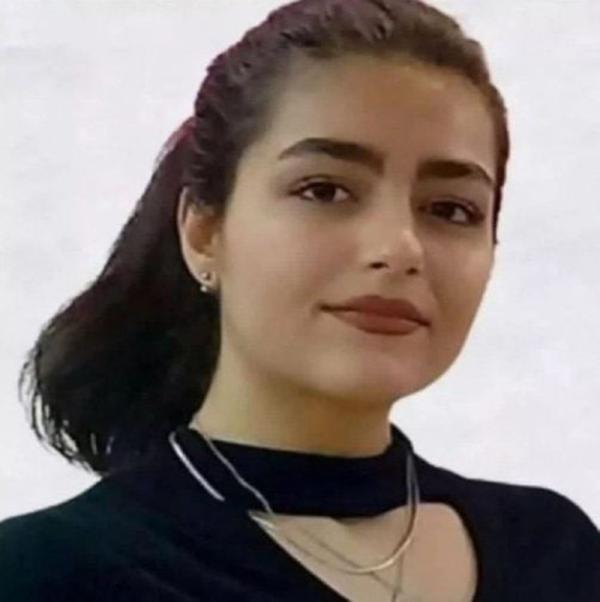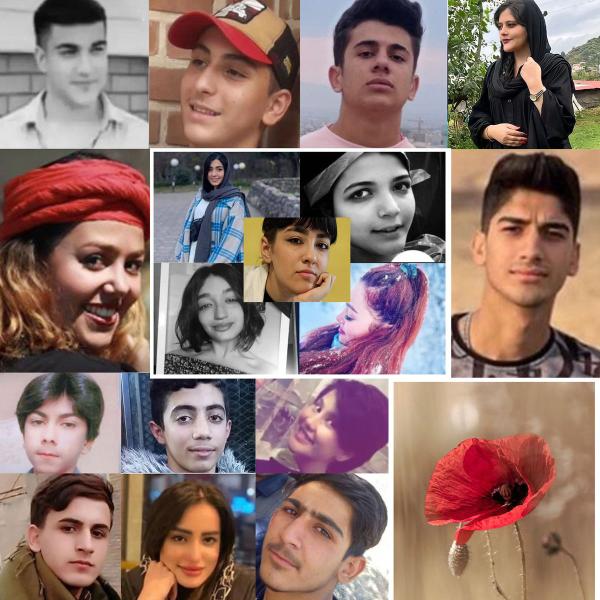On September 16, a 22-year-old Kurdish woman, Mahsa Amini, was arrested by authorities for minor deviations from the strict dress code the Islamic fundamentalist regime imposes on girls and women. Mahsa died in their custody. This was the straw that broke the camel’s back, unleashing a torrent of anger and sorrow at the hated regime among millions of Iranian women and men.
Five weeks later, even in the face of truly barbaric and murderous repression1, the outpouring has continued relentlessly across the country, drawing in new forces from among high school age youth, the many oppressed nationalities in Iran, artists, computer hackers and many others.
High School Girls Enter the Battle
Starting in early October, even as beatings and killings of protesters aimed to scare people off the streets, thousands of utterly fearless high school age girls began to enter the movement and soon became a major and inspiring force, protesting in classrooms, playgrounds and on the streets.
The Iranian authorities are as brutal towards these brave children as they have been to adults. On October 8, 17-year-old Abolfazl Adinezadeh was shot at close range with birdshot by police during protests in the city of Mashad. When his parents came to pick him up at the police station on October 9, he was dead from serious injuries to his liver and kidneys.
Four days later, authorities at Shahed High School in the Iranian town of Ardabil2 tried to force the girls there to sing “Hello Commander,” an anthem praising Supreme Leader Khamenei. Many started chanting against the government instead, and were attacked and beaten by plainclothes security. After returning to class, they were attacked again—seven students were injured and 10 arrested. 15-year-old Asra Panahi was one of those beaten and later died in the hospital of her injuries.3 This in turn led to furious protests in Ardabil, with stone-throwing crowds chanting “Freedom” clashing with security forces.

Asra Panahi, 15
BBC reports that Iran’s education minister has confirmed that an unspecified number of children “had been sent to ‘psychological centres’ after they were arrested allegedly for participating in protests.”
All this has been met with even more determination from the youth. Speaking of the murder of Asra and other teenagers, a 19-year-old girl said:
I don’t have a single relative in Ardabil, but with this brutal crackdown on our sisters, who were just 16 years old, they’ve awakened the whole nation. We never knew we were so united – across the Baloch regions as well as the Kurdish regions4. The world has heard about Nika, Sarina and Asra, but there are so many other nameless children who we know nothing about. It’s not just Asra’s death. The Islamic Republic has been killing our people for 40 years, but our voices weren’t heard.
Let the world know this is no longer a protest—we are calling for a revolution. Now that you’re all listening to our voices, we will not stop.

Some Iran students who have been killed fighting for freedom.
Massacre at Evin Prison
“Evin Prison”—the words alone have evoked fear in the hearts of Iranian people for over 50 years. Evin is a massive complex of prison buildings holding up to 15,000 inmates, from people convicted of petty crimes to dissidents whose “crime” is to speak out or protest against the barbaric regime. Evin was a hideous dungeon and torture chamber under the U.S.-backed Shah of Iran until he was overthrown in 1979, and it hasn’t changed under the fascist theocrats who now rule Iran.
On October 15, amidst shooting, tear gas and beatings unleashed by prison authorities against inmates, a major fire broke out in one of the main buildings. Much remains unknown about that night, including how the fire started. But what seems clear from available evidence and testimony is the prison authorities had been preparing for days for some kind of assault on the prisoners, and that on the evening of October 15 they carried it out, leading to the deaths of at least eight prisoners and injuries to at least 61.5
A Reuters report painted a vivid picture of the unfolding terror and heroism inside the prison:
Tensions rose when inmates, provoked by the riot police chanting religious slogans and hammering batons on cell doors, responded with "Death to Khamenei". Then, at about 8 p.m., shots were fired by the riot police … [An inmate in the political prisoners’ section said] “When we heard shots and chants, we tried to break the door and get to the corridor to help other prisoners from ward 7 who broke the door and were clashing with the riot police and prison guards in the corridor. Everyone was scared.” … Riot police and prison guards fired teargas and metal pellets at hundreds of prisoners and beat people with batons. … “They opened the door of our ward (8) and were shooting at us with pellet guns. Fired tear gas. Dozens, dozens of them were there. Many people in our ward were injured and could not breathe. … We could hear gunshots, prisoners were screaming, guards were shouting, they opened the door and threw so much tear gas inside and used pellet guns. Many inmates fainted, dozens were injured. It was like a war zone.”6
Amnesty International (AI) spoke to prisoners, family members and journalists and human rights activists who have contacts inside the prison. They reported that:
The Iranian authorities have blamed prisoners for the fire that engulfed areas of Evin prison on 15 October, but evidence gathered by Amnesty International raises serious concerns that the authorities sought to justify their bloody crackdown on prisoners under the guise of battling the fire and preventing prisoner escapes. … [P]rison officials at Evin prison and anti-riot police repeatedly fired teargas and metal pellets at hundreds of prisoners, and subjected many to brutal beatings with batons, particularly on their heads and faces. … [E]yewitness accounts emerging from inside the prison indicating that security forces pointed guns to the heads of several women prisoners and may have also fired live ammunition towards some male prisoners.
The Iranian authorities have so far confirmed eight deaths and 61 injuries of prisoners, but prisoners fear that the number of those killed and injured may be far higher. Consistent with long-standing patterns of denial and cover-up of their crimes, the authorities swiftly issued statements attributing the deaths to asphyxiation from smoke inhalation and fighting among the inmates.
The arbitrary and abusive force used by Iran’s security forces and prison officials against prisoners who were confined within the walls of a prison affected by fire and had no chance to escape offers further evidence of the extreme brutality Iranian authorities routinely use to crush dissent.7
In addition, AI pointed to the prison authorities’ acknowledgment that Evin prison is surrounded by anti-personnel minefields. Under international law these mines are illegal under any circumstances, and truly speak to the barbarity of the Iranian authorities.
Based on this still-emerging picture, Amnesty issued a demand that “The Iranian authorities must immediately allow independent international monitors unhindered access to Iranian prisons to investigate the harrowing use of unlawful force by security forces at Tehran’s Evin prison on 15 October and to protect prisoners from further unlawful killings, torture and other ill-treatment.”
A Fire That Continues to Spread
To this point, despite the enormous, blood-curdling violence unleashed by the Islamic Republic, protests have continued, drawn in new forces, and developed new tactics to deal with the intense repression—it is a fire that continues to spread.
Particularly notable is the depth of resistance in oppressed nationality areas like Kurdistan, Baluchistan and Azerbaijan, where the fury at the treatment of women is also tapping into the decades of anger at discrimination against minority peoples. A recent report from Tabriz—the capital of East Azerbaijan Province—describes it as a “hotbed of unrest,” with people setting fires and fighting with police well into the night. The city of Marivan in Kurdistan has been another center of protest, with “young women unveiling in public and chanting anti-government slogans.”
As we reported previously, strikes have also broken out in the strategic oil sector, and a more recent report says that strikes have spread to “gas, petrochemical, pipe mills, sugar cane, and tire factories.” Artists have taken steps like pouring red dye into the fountains of Tehran so it appeared they were full of blood, or projecting Mahsa Amini's face onto the side of a residential tower block as protesters chanted slogans from apartments and rooftops.
All this underscores the great urgency of organizing mass solidarity with the Iranian people and spreading the ongoing analysis and leadership of the Communist Party of Iran (Marxist-Leninist-Maoist) in the U.S. and across the globe.